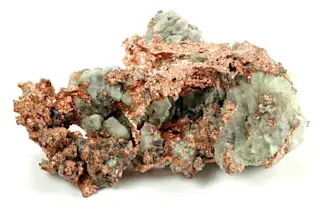In Ytterby there are two secret pasts. Two centuries ago, the sleepy village—now dotted with vacation homes belonging to wealthy residents of nearby Stockholm—was a restless mining settlement, shipping out high-grade feldspar for the royal porcelain factories of Europe and quartz to line the blast furnaces springing up across England. It is also the birthplace of some of nature’s most wondrous and least appreciated chemical elements.
The latter story began in 1787, when an amateur geologist named Carl Arrhenius was visiting a mine in Ytterby. He discovered an unusually heavy black rock among the gray outcroppings and, being a man of healthy scientific curiosity, sent a sample for analysis to Johan Gadolin, a prominent chemist at the Royal Academy of Turku in Finland. In 1794 Gadolin concluded that the specimen contained an entirely new element, later named yttrium. By 1879 chemists had isolated six additional elements from the same rock, bringing the grand total in the newly invented periodic table to 70. Three of those elements—ytterbium, erbium, and terbium—were simply given additional variants on the name of Ytterby, while the other three were named holmium (for Stockholm), scandium, and thulium (both from the Latin for Scandinavia), in the nationalistic fashion then in favor. After a long, lucrative run, the Ytterby quarry was closed in 1933. In many ways, though, the town’s influence looms larger than ever. The elements discovered there, known collectively as rare earths, today form the backbone of the modern wired and wireless world—even though you have probably never heard of them.
The name rare earths made sense to the 19th-century mind: rare because it seemed at first that they came only from Scandinavia, and earths because they occurred in an earthy oxide form from which it was exceptionally hard to obtain the pure metal.
Today it is clear that the rare earths are hardly rare. The most common of them, cerium, ranks 25th in abundance in the earth’s crust, one place ahead of homely copper. Yttrium is twice as abundant as lead; all of the rare-earth metals (with the exception of radioactive promethium) are more common than silver. The “earths” part is also misleading. These elements are actually metals, and quite marvelous ones at that. The warm glow of terbium is essential to high-efficiency compact-fluorescent bulbs. Europium is widely exploited to make vivid displays for laptop computers and smart phones. Rare earths also pop up in more unexpected places like baseball bats, European currency, and night-vision goggles.
With their growing popularity comes new value, and even political notoriety. Terbium and europium recently overtook silver in price, reaching $40 an ounce. The growing demand for rare earths has become the subject of numerous government reports and a bill that passed in the House of Representatives. The reason these elements are causing such a stir is not their scarcity but their inaccessibility. Rare earths tend to occur in hard rock such as granites, where they lump together in a uniform way that makes them difficult to extract.
Separating out the desired elements demands a toxic and dangerous process, and China has the best infrastructure for doing so economically. China holds about 36 percent of the world’s 110 million tons of recoverable rare-earth ores, with the rest scattered worldwide, principally in the United States, India, Australia, and Russia. Yet China currently produces as much as 97 percent of the world’s rare-earth oxides, according to the U.S. Government Accountability Office. Pekka Pyykkö, a professor of chemistry at the University of Helsinki, puts it this way: “Not all the deposits are in China, but the processing capacity right now is.”
Supply would not matter if not for demand, and the demand comes from the unusual electrical properties of the rare earths—or lanthanides, as chemists prefer to call them, because they mostly follow lanthanum in the periodic table of elements. The lanthanides share similar chemical properties because they all react similarly, mostly with their three outer electrons. (An atom’s arrangement of electrons is what determines most of its physical and chemical attributes.) Like copper, iron, cobalt, and other more familiar metals, lanthanides form many colored compounds. The magic happens when those outer electrons change energy states and release visible light. But the rare earths are especially valuable for their property of fluorescence: They can absorb light or ultraviolet rays and re-emit the energy as an eerie glow of certain colors specific to each element. The brilliant emission of red and green is the reason why lanthanides are indispensable components of today’s television sets and compact fluorescent bulbs.
From a technological perspective, a more intriguing trait of the rare earths is that some of them are highly magnetic. Alloyed with other metals, they make extraordinarily strong and compact magnets: perfect for computer hard drives, cordless power tools, microphones, and headphones. An iPod takes a triple sip of rare earths: to store digital music, to re-create it in earbuds, and to display what is playing. An iron alloy containing terbium and dysprosium has a particularly useful property: It expands and contracts efficiently in the presence of a magnetic field. Sensors, actuators, and injectors commonly use such materials, for instance to regulate the flow of gasoline into an automotive engine.
Compact, powerful magnets are key components for efficient generators and electric motors, and this makes rare earths star players in green technology. (Molycorp Minerals—the biggest rare-earth mining operation in the United States—optimistically calls them “the green elements.”) Lanthanide-flecked supermagnets are used to generate electricity in wind turbines. A turbine capable of generating 2.5 megawatts of power typically uses 700 pounds of neodymium. High-speed maglev trains make extensive use of such magnets to levitate the cars above their tracks. The Toyota Prius is practically a rolling exhibit of rare earths, containing eight different elements, for a total of 25 pounds of rare earthiness.
But the commercial versatility of the lanthanides extends far beyond the world of electronics. Cerium is a prime example. It was discovered in 1803 by Swedish chemist Jöns Jacob Berzelius, who named it after the asteroid Ceres, discovered two years earlier. (Ceres was then regarded as a new planet and so was much celebrated.) In 1885 the Viennese chemist Carl Auer von Welsbach found that a pinch of cerium oxide, together with thorium oxide, usefully increases the brightness of a gas lamp. Soon after, Auer discovered that a mixture of cerium and iron readily generates sparks. The alloy, which he modestly called Auermetall, is still used to ignite the flame in cigarette lighters.
Cerium’s applications kept multiplying. A fine powder of cerium oxide, known as optician’s rouge, is an excellent abrasive for polishing glass. Cerium compounds form nontoxic red pigments that are used in toys and household products. In medicine, cerium compounds were once administered for everything from tubercular coughing to seasickness; today those treatments are mostly regarded as quackery, but the element still earns its place in hospitals as an antiseptic wash for severe burns.
You may have cerium oxide in your kitchen if your oven is a self-cleaning model; it helps breaks down burned-on leftovers. You certainly have cerium oxide in your car, assuming it is less than 35 years old. The compound works to convert carbon monoxide emissions in automotive exhaust to less harmful carbon dioxide. As a fine powder mixed into diesel fuel, cerium oxide can also clean up the sooty fumes produced by trucks and buses. Industry consumes 55,000 tons of cerium every year. The element, pulled from a type of weathered granite called monazite, fetches about $60 a pound.
Useful and yet so unfamiliar: the average person is still largely in the dark about rare earths, even though many of them are literally casting light into the world. Cerium is a crucial element in the intense, white-light arc lamps used by moviemakers to illuminate the action on-set. Glass doped with cerium oxide effectively absorbs ultraviolet light. That makes it useful for UV-blocking windows and sunglasses, as well as for protecting X-ray equipment from radiation damage. Two other rare-earth metals, neodymium and praseodymium, work their magic at the other end of the spectrum. They impede infrared light and so are incorporated into welders’ goggles to protect workers’ eyes from the heat. These oxides also absorb yellow and green, so glass made with them has a characteristic mauve tinge.
More broadly, rare earths add color to our world because of their rich and varied optical properties. The glazes on earthenware dishes and vases commonly contain oxides of tin (white), copper (blue), or iron (amber). But rare-earth oxides can dissolve in the glaze to create more exotic hues, such as pink and lime green, with a sharp, electric appearance that artists love. “They can be transparent, which really brings ceramics alive,” says David Pier, a ceramicist in Chapel Hill, North Carolina. Adding erbium oxide, for example, gives a subtle tone—“more pink lemonade than Pepto-Bismol,” as Pier describes it.
Colorful fluorescence is the calling card of another rare-earth element with another odd name: europium. Elements were frequently named for the town or region where they were discovered, sometimes in a very provincial manner, as was the case with yttrium. Europium runs against the trend. It was the last of the natural lanthanides to be found, in 1901. In that year, Frenchman Eugène-Anatole Demarçay isolated the element as an impurity in samples of another rare earth, samarium (named, indirectly, after Russian mine official V. E. Samarsky-Bykhovets). In a fit of magnanimity, Demarçay decided to name his element not after Paris, where he worked, or after France, but in honor of all Europe.
All the rare earths, europium is perhaps the most visible. It is used in the phosphors of display screens, where it emits red and blue light. A little europium is also added to mercury vapor streetlamps to whiten their otherwise cold blue light. It even has found its way into the wallet. Officials at the European Central Bank evidently decided it would be fitting if europium-based compounds were added to euro banknotes as fluorescent security markings. When the notes are inspected under a bank’s ultraviolet scanner, pictures of a bridge and the European continent light up in green. The relationship between europium and the euro was not announced; it was revealed only when Freek Suijver and Andries Meijerink, two curious chemists at the University of Utrecht in the Netherlands, put the notes into their spectrometer. They had a good laugh but were unable to determine who concocted this sophisticated inside joke. “I learned that the use of europium was intentional,” Meijerink says, “but I am sorry to say that I have no inside information on who, where, and how it was decided to use the europium luminescence.”
The importance of the rare earths is no secret in the industrialized world, however. One year ago, when China announced it would limit exports, the commodity price of all the rare earths almost instantly shot up. In just six months the price of samarium oxide quadrupled, to more than $50 a pound in May of this year, owing to its property as a permanent supermagnet when alloyed with cobalt. Samarium’s ability to stay strongly magnetic in extreme temperatures makes it a favorite of the military for use in precision-guided weapons. In April, China took steps to keep prices high by extending a national ban on rare-earth exploration and the opening of new mines.
For all the dire headlines, the latest rare-earth frenzy may be little more than a bubble. Not so long ago, China aggressively pursued cheaper means of isolating rare earths, benefiting from the absence of costly environmental regulations, which is how the country acquired its current near-monopoly. But its dominance could well be temporary. “Because of its cheap prices, the competitors closed down,” says Pekka Pyykkö. “In the present situation, new capacity will undoubtedly be restarted.”
Mountain Pass, California, is one of the places where American rare earths may rise again. Here, Molycorp used to meet much of the world’s demand for these elements. The company shuttered its operations in 2002, but earlier this year it reopened its mine. Another American company, U.S. Rare Earths, owns mineral rights to lanthanide resources in Montana and Idaho; according to a report by the Government Accountability Office, these are in “early exploratory stages of development.” Mines in these areas may take up to 15 years to bring online, the report states, “largely due to the time it takes to comply with multiple state and federal regulations.”
A visit to other parts of the periodic table could also turn up substitutes for some of the lanthanides. In January, Toyota—spooked by rising prices and supply concerns—announced that it is developing a new type of propulsion, called an induction motor, for future electric and hybrid vehicles. The technology notably does not rely on rare-earth elements.
For now, though, the world is hooked on the lanthanides, and China is the only place that has the processing capacity up and running. As for Ytterby, that mine at least is unlikely to reopen. It is now a historic landmark, located just off the intersection of Terbium and Mine roads. A small sign commemorates it on the quayside, noting the site’s prodigious contribution to chemistry.
Life on Lanthanides: Toyota Prius
Toyota has sold 2 million Priuses globally since the car’s introduction in 1997, including a million in the United States. Unfortunately, while the world’s most popular hybrid sips gasoline, it devours rare earths. The Prius gets its juice from a battery pack that contains about 20 pounds of lanthanum, which shuttles electrons between the battery’s positive and negative terminals. Powerful magnets in the Prius’s electric motors incorporate neodymium, whose cost shot up 150 percent in the first third of 2011. The price of lanthanum has increased sevenfold, to $60 a pound, over the past year, and in 2010 China briefly suspended rare-earth shipments to Japan in a diplomatic dispute. Toyota is working with the electric car company Tesla Motors to install rare-earth-free motors in future vehicles.
Life on Lanthanides: Baseball Bats
Are you the weakest player on your company softball team? One perfectly legal way to boost your performance is to use a metal bat infused with the rare-earth element scandium. When mixed with aluminum, the silvery-white element shrinks and refines the grains of the metal, making an alloy that is highly resistant to cracking. “Just a little bit lets you build a stronger bat without sacrificing resilience and durability,” says Dewey Chauvin, director of bat engineering at Easton Sports. “You can add more features to the bat, like a longer barrel and hence a larger sweet spot, without incurring weight.” But scandium production is so low that the element—which is also used in bicycle frames and lacrosse sticks—can cost hundreds of dollars a pound, limiting its use to top-of-the-line bats priced at $150 or more.
Life on Lanthanides: Smart Phones
The era of ever-shrinking consumer electronics would be virtually impossible without rare earths. Neodymium is one of the most important elements here because of its powerful magnetic properties. In modern cell phones, neodymium is a key ingredient in the wafer-thin permanent magnet that converts electric signals to sound waves in speakers and headsets. It is also used in the small motors that vibrate when you turn your ringer off. Other rare earths are crucial for the vivid displays in smart phones, televisions, and laptops. Europium and terbium emit red and green light, respectively, and their market value rose more than 75 percent in the first four months of 2011. Expect demand to sharpen as color touch screens become more common with the spread of tablets and e-readers.
Life on Lanthanides: Wind Turbines
Carbon-free electricity gets a big boost from rare earths. Behind the rotors of a wind turbine, wire coils move through a magnetic field to generate current. To maximize efficiency, manufacturers like General Electric often use high-intensity magnets that incorporate rare-earth elements. Some turbines contain 700 pounds of neodymium. “Without rare earths, you’d have to use larger, heavier magnets, and you’d have to build a stronger, more expensive tower to support them,” says materials scientist Alex King of the U.S. Department of Energy’s Ames Laboratory. Last year GE received a $2 million federal grant to develop magnets with only one-fifth the rare-earth content of today’s offerings.














